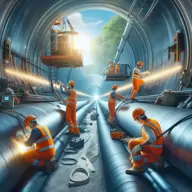GRE (Vessel / Piping/pipeline)

Language
English
80 Views
1 Enrollments
Share
Coming in February, 2025
-
-
This course format is where trainer will explain you the subject via online live session. Date and time are not decided yet but it will be planned within next 2 weeks after you enroll & pay for this course. Get in touch with our team if any clarification is required.
₹ 499
online

₹ 499
Why do you enroll
Key topics covered
Course details
Course tags
Why do you enroll
Mastering GRE (Glass Reinforced Epoxy) for Vessel, Piping, and Pipeline applications can significantly enhance your career in industries like oil and gas, chemical processing, and marine engineering, leading to roles like GRE Engineer, Composite Materials Specialist, or Pipeline Integrity Manager, with median salaries ranging from $100,000 to over $150,000. With this training, you'll gain expertise in designing, fabricating, and installing GRE systems for corrosion-resistant and durable applications, ensuring long-term performance and reliability. This knowledge will also equip you to develop and implement GRE-based solutions for complex engineering challenges, optimize system design and installation, and ensure compliance with industry standards and regulations. As a certified GRE professional, you'll be highly valued for your ability to deliver innovative, cost-effective, and sustainable solutions for demanding industrial applications.
Show more
Key topics covered
ntroduction to GRE (Glass Reinforced Epoxy) Materials
Overview of GRE: Definition, composition, and key characteristics of Glass Reinforced Epoxy
Advantages of GRE over traditional materials like steel, PVC, and concrete in vessels, piping, and pipelines
Properties of GRE: high strength-to-weight ratio, corrosion resistance, and excellent thermal stability
Applications of GRE in various industries: oil and gas, chemical processing, water treatment, and marine applications
Understanding the manufacturing process of GRE: fiber-reinforced composite materials and epoxy resin matrix
Material Properties of GRE for Pipeline and Vessel Applications
Mechanical Properties: tensile strength, compression strength, flexural strength, and impact resistance
Thermal Properties: thermal conductivity, operating temperature range, and coefficient of expansion
Chemical Resistance: resistance to acids, alkalis, solvents, salts, and other aggressive chemicals
Electrical Insulation: non-conductive nature of GRE for use in electrical and electronic systems
Corrosion Resistance: GRE's role in preventing corrosion and minimizing maintenance costs
Fatigue resistance and suitability for dynamic load applications in pipelines and vessels
Manufacturing and Fabrication of GRE Vessels, Piping, and Pipelines
Production processes for GRE components: filament winding, pultrusion, hand lay-up, and resin transfer molding (RTM)
Filament winding: process details, applications in pipeline and vessel manufacturing, and quality control
Pultrusion: continuous composite manufacturing process for GRE pipes and profiles
Resin systems and their impact on the properties of GRE: epoxy resins, curing agents, and additives
Fabrication of GRE fittings, flanges, joints, and valves: techniques for joining GRE components
Design Considerations for GRE Piping and Vessels
Load-bearing capacity and stress analysis for GRE piping and vessels
Wall thickness and pressure rating calculations based on fluid characteristics and operating conditions
Flexural and bending analysis for GRE pipes in dynamic environments (e.g., thermal cycling, seismic activity)
Design standards and codes for GRE piping systems: ASME, ASTM, ISO, and other international standards
Long-term performance prediction: understanding fatigue, creep, and stress rupture in GRE materials
Impact of installation and operational conditions (temperature, pressure, flow rate) on GRE systems
Installation of GRE Pipes and Vessels
Pre-installation preparation: handling, storage, and transportation of GRE pipes and components
Techniques for GRE pipe installation: trenchless technology, direct burial, and above-ground installation
Joints and connections: flange joints, threaded joints, bonded joints, and mechanical couplings
Installation of GRE vessels: mounting, support, and anchorage considerations
Handling of GRE during installation: special tools, lifting techniques, and protection from damage during transport and installation
Jointing and Welding Techniques for GRE
Types of joints for GRE piping systems: butt fusion, socket fusion, and adhesive bonding
Methods for joining GRE pipes: electrofusion welding, mechanical couplings, and flanged connections
Installation and inspection of GRE couplings and fittings
Quality assurance and testing of joints: visual inspection, hydrostatic testing, and ultrasonic testing
Maintenance and repair of GRE joints: methods for repairing leaks and cracked joints without full system replacement
Corrosion Resistance and Maintenance of GRE Systems
Corrosion resistance of GRE piping and vessels in harsh environments (e.g., chemicals, seawater, soil exposure)
Common forms of degradation: UV degradation, surface cracking, and chemical attack
Protective coatings for GRE: UV-resistant coatings and anti-abrasion coatings for external surfaces
Preventive maintenance strategies: monitoring and inspecting GRE systems for potential damage, wear, or degradation
Techniques for repairing and restoring damaged GRE components: patching, reinforcement, and re-lining
Testing and Quality Control for GRE Pipelines and Vessels
Types of testing for GRE pipelines: hydrostatic testing, pneumatic testing, and pressure testing
Non-destructive testing (NDT) techniques: ultrasonic testing, radiography, and visual inspection
Destructive testing for GRE: tensile, compression, and impact testing of GRE materials and joints
Quality control procedures during manufacturing, installation, and operation of GRE systems
Ensuring compliance with industry standards: ASTM, ISO, and local/regional regulations
Fire Resistance and Safety Considerations
Fire safety of GRE systems: materials' behavior under extreme temperatures and fire conditions
GRE’s fire-resistant properties: fire retardant additives and coatings for GRE pipes and vessels
Safety protocols for working with GRE materials: handling, installation, and disposal of GRE components
Fire protection strategies for GRE pipelines in hazardous environments (e.g., oil and gas, chemical processing)
Regulatory requirements for fire safety in GRE applications and fire-resistant testing standards
Cost Considerations and Life Cycle Cost Analysis (LCCA)
Initial costs of GRE vs. traditional materials (e.g., steel, PVC, and concrete)
Long-term operational costs: maintenance, corrosion protection, and energy efficiency
Total cost of ownership: factoring in installation, lifespan, and repair/replacement costs
Lifecycle cost analysis for GRE piping and vessels in industrial, municipal, and commercial applications
Cost-benefit analysis of using GRE for specific applications (e.g., chemical transport, water systems)
Show more
Course Details
This comprehensive course provides an in-depth exploration of Glass Reinforced Epoxy (GRE) technology and its applications in vessel, piping, and pipeline systems. Designed for engineers, designers, and industry professionals, the course covers the fundamental principles, design considerations, installation practices, and maintenance strategies associated with GRE systems.

Course tags
Industry domains :
Engineering Disciplines :
Mechanical , Metallurgy & Material Science , Piping & Layout
FAQs on GRE (Vessel / Piping/pipeline)
Having specific question ? Ask now
Trainer’s Feedback
5 course rating
1 ratings
mg
mani giri
2 months ago
Very useful for me I'm inthe welding inspection filed so very useful full notes and tips I get through this and learning also lot
Certificate of Mastery

Receive well recognised certificate that you can showcase on
Featured courses
Hazard Identification and Risk Assessmen...

How to prevent corrosion in the oil and ...

Application and use of "Green Hydrogen"

Career in EPC projects for Freshers

Career in EPC Cost Estimation

Learn MATLAB Programming

More Technical Courses From Chaitanya Purohit
Mastering Project Management: Delivering...

Mastering Supply Chain Management: Optim...

Mastering Six Sigma: Driving Quality and...

Kaizen: The Art of Continuous Improvemen...

Welding Technology - Basics

Engineering Materials - Material Manufac...

Engineering Materials - Iron & Steel mak...

Engineering Materials - Material Classif...

Similar Content Learn:
Fundamentals of Quality, QMS & ISO-9001

Buffer Tank - Basic, Concept, Design, Ca...

Business Excellence through Quality, QMS...

Similar Content Mentor:
All About Interviews

Presentation Skills _ Part 2

Similar Content Seminar:
7th International Oil & Gas Chemistry, C...

Similar Content Blogs:
PRC Europe 2025: Italian Partners at the...

Technical Basis for Impact Test Exemptio...

A brief mathematical overview of the for...

Aerodynamic physics of the Delta Wing

Seal of Hydraulic cylinder.

Similar Content Community:
Firefighting Design By Naga

Engineer's Corner

Cathodic protection

Corrosion

Cae engineers

Similar Profile:

Vijay Sachdev
Consultant - Project & Pr...

Debojyoti sen
MD & CEO, SAURYAJYOTI REN...

Sabari Kuppuraj
Engineer

Atul Kabre
Independent Consultant

Anup Kumar Dey
Owner of https://whatispi...

Jyoti Swarup
--

Praveen Tiwari
--

Please wait
































